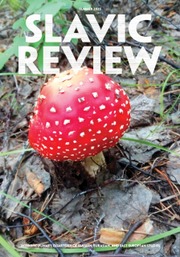No CrossRef data available.
Article contents
Threads, Entanglements, and the Work of Empire
Published online by Cambridge University Press: 30 October 2025
Abstract
This response to “Horizontal Threads: Towards an Entangled Spatial History of the Romanov Empire,” reflects on shifting approaches to the structure of empires and the power of entanglement as an analytical tool for making sense of the incorporationist work of empire.
Keywords
Information
- Type
- Critical Forum: Entangled Spatial History
- Information
- Copyright
- © The Author(s), 2025. Published by Cambridge University Press on behalf of Association for Slavic, East European, and Eurasian Studies.
References
1 Tony Ballantyne, “Mr. Peal’s Archive: Mobility and Exchange in Histories of Empire,” in Antoinette Burton, ed., Archive Stories: Facts, Fictions, and the Writing of History (Durham, 2005), 87–110.
2 Tony Ballantyne, Orientalism and Race: Aryanism in the British Empire (Basingstoke, 2002), 15.
3 Tony Ballantyne, Between Colonialism and Diaspora: Sikh Cultural Formations in an Imperial World (Durham, 2006), especially chapter 2.
4 Antoinette Burton, Burdens of History: British Feminists, Indian Women, and Imperial Culture, 1865–1915 (Chapel Hill, 1994); Mrinalini Sinha, Colonial Masculinity: the ‘manly Englishman’ and the ‘effeminate Bengali’ in the Late Nineteenth Century (Manchester, 1995); Catherine Hall, Civilising Subjects: Colony and Metropole in the English Imagination, 1830–1867 (Chicago, 2002). Elements of this approach had been anticipated in the final chapter of Catherine Hall, White, Male and Middle Class: Explorations in Feminism and History (Cambridge, Eng., 1992).
5 Two examples of historians work were Ballantyne, Orientalism and Race and Zoë Laidlaw, Colonial Connections, 1815–45: Patronage, the Information Revolution and Colonial Government (Manchester, 2005). Key works by historical geographers include: Alan Lester, Imperial Networks: Creating Identities in Nineteenth-Century South Africa and Britain (London, 2001), and “Imperial Circuits and Networks: Geographies of the British Empire,” History Compass 4, no. 1 (January 2006): 124–41; Alan Lester and David Lambert eds, Colonial Lives Across the British Empire: Imperial Careering in the Long Nineteenth Century (Cambridge, Eng., 2006).
6 Most notably, Dilip Hiro, Black British, White British (London, 1971); Rozina Visram, Ayahs, Lascars, and Princes: Indians in Britain, 1700–1947 (London, 1986); Paul Gilroy, There Ain’t No Black in the Union Jack: The Cultural Politics of Race and Nation (London, 1987).
7 Catherine Hall, Nicholas Draper, Keith McClelland, Katie Donington, and Rachel Lang, Legacies of British Slave-Ownership: Colonial Slavery and the Formation of Victorian Britain (Cambridge, Eng., 2014); David Olusoga, Black and British: a Forgotten History (London, 2018); Sathnam Sanghera, Empireland: How Imperialism Has Shaped Modern Britain (London, 2021).
8 Jane Carey and Jane Lydon, eds, Indigenous Networks: Mobility, Connections and Exchange (New York, 2014); Rachel Standfield, ed., Indigenous Mobilities: Across and Beyond the Antipodes (Acton, Australia, 2018).
9 Mark von Hagen, “Writing the History of Russia as Empire: The Perspective of Federalism,” in Catherine Evtuhov and Boris Gasparov, eds., Kazan, Moscow, St. Petersburg: Multiple Faces of the Russian Empire (Moscow, 1997), 397.
10 John Randolph and Eugene M. Avrutin, eds, Russia in Motion: Cultures of Human Mobility since 1850 (Urbana, Illinois, 2012; Sylvia Sztern, Russia on the Move: Railroads and the Exodus from Compulsory Collectivism, 1861–1914 (Cham, Switzerland, 2022); Anne Lounsbery, “The World on the Back of a Fish: Mobility, Immobility, and Economics in ‘Oblomov,’” The Russian Review 70, no. 1 (January 2011): 43–64. A broader set of perspectives that include Russia is Róisín Healy, ed., Mobility in the Russian, Central and East European Past (London, 2019).
11 William Cronon, Nature’s Metropolis: Chicago and the Great West (New York, 1992), 384.
12 Charles Steinwedel, Threads of Empire: Loyalty and Tsarist Authority in Bashkiria, 1552–1917 (Bloomington, 2016), 8.
13 Steinwedel, Threads of Empire, 8, 37–8, 65–7, 80, 248, 254; Karen Barkey, Empire of Difference: The Ottomans in Comparative Perspective (Cambridge, Eng., 2008).
14 Barkey, Empire of Difference, 10.

